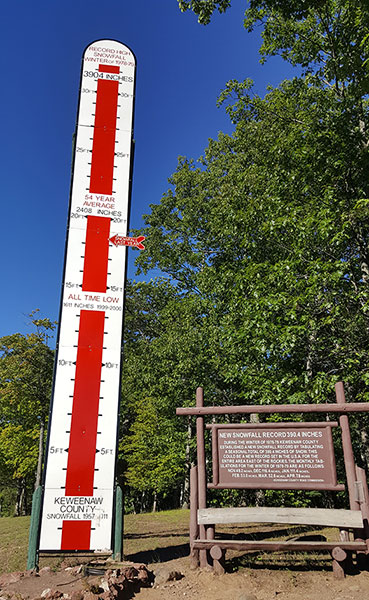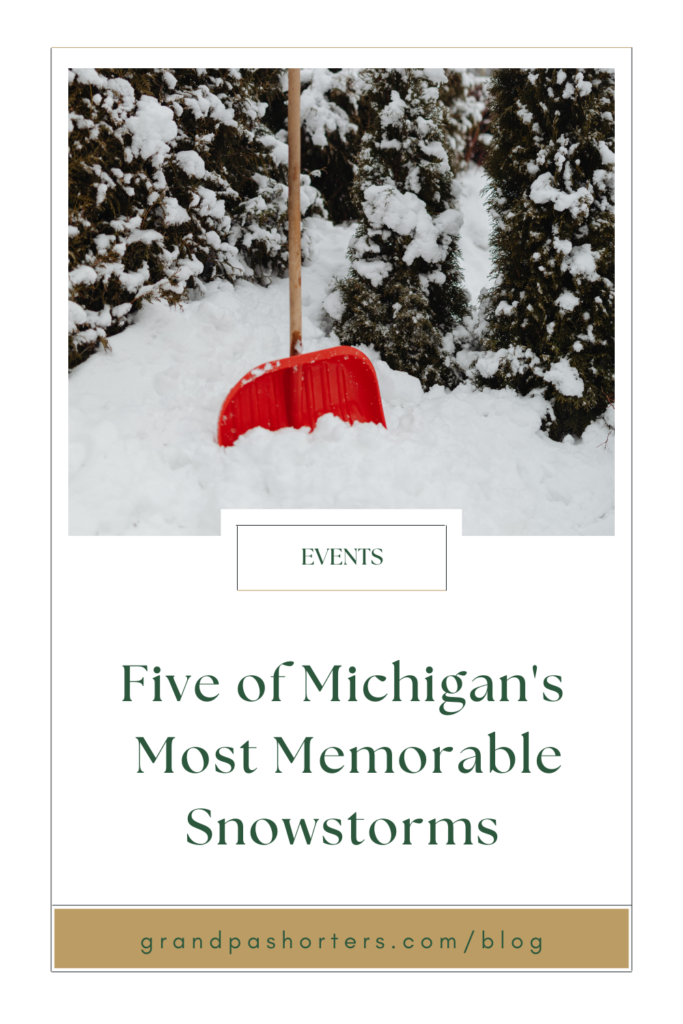Five of Michigan’s Most Memorable Snowstorms
Michigan winters are known for their cold and snow. Based on statewide averages, our state ranks as the sixth snowiest in the Union. On a list of snowiest U.S. cities with populations greater than 100,000, Michigan has the most with four cities in the top 25; Grand Rapids is highest at number four. Only the cities of Syracuse and Rochester, New York, and Anchorage, Alaska, beat out G.R. The small Upper Peninsula town of Calumet is the snowiest place in Michigan with a yearly average of 187.4 inches and a record total of 390.4 inches set during the winter of 1978-79.

With all that snow, you can bet Michigan has seen its share of big snowstorms. Here are five of Michigan’s biggest snowstorms in recent history.
1. The White Hurricane of 1913
Technically, Michigan doesn’t have hurricanes. But anyone who lived through the Great Lakes storm of November 1913 would probably disagree.
Called the White Hurricane, it’s considered one of the worst snowstorms to hit the region in recorded history. This blizzard with hurricane-force winds blew across Michigan’s Upper and Lower Peninsulas and into Ohio, New York and Ontario, Canada, for four days. It left a path of devastation in its wake, toppling ships on the Great Lakes, killing 250 people. Two powerful low fronts, one from Alberta and one from Colorado, converged over the Great Lakes, picking up energy from the still-warm lake water.
Typically these storms are called November Gales, but in 1913 wind gusts reached hurricane speeds of up to 90 mph, producing 35 foot waves on the big lakes. Sustained winds across the entire state of Michigan are believed to have reached 60 to 70 mph. Waves ripped apart breakwaters, and the wind smashed telephone poles and powerlines.
Lake Huron took the worst hit, losing several ships that were in the area en-route to and from the St. Mary’s River and Lake Erie. About 235 mariners lost their lives on Lake Huron during the horrific storm.
Snowfalls of almost two feet crippled cities and towns across Michigan and other Great Lakes states. Snowdrifts from the strong winds reached more than four feet.
2. The Late May Snowstorm of 1923
Can it really snow in Michigan in May? Yes it can! An awful lot in fact. While this storm caused little damage and only dropped about a foot of snow in some of the hardest hit locations, it was still considered a significant storm because it caught everyone off guard.
Imagine, it’s a warm spring day, then suddenly the mercury plunges. That’s exactly what happened on May 8, 1923. Temperatures across Michigan fell from 62 degrees to just 34 between noon and six that evening as a strong cold front approached. An inch of snow fell that night. While that was unusual, Michigan was in for an even more rare occurrence.
The following day, a low-pressure system joined up with the cold front, leaving six to nine inches of snow over most of the area, despite the ground already warming up from spring. Areas near Lansing and Flint were buried in a foot of snow! Temperatures didn’t rise out of the 30s for two days.
3. The Blizzard of 1967
The days prior to January 26 and 27, 1967 were unseasonably warm with temperatures in the 50s and 60s in some parts of Michigan. Then suddenly, winter temperatures returned, and with them came several feet of snow. An eight-mile long traffic backup occurred between Grand Rapids and Jackson, with drivers abandoning their cars and walking to a nearby farmhouse to spend the night. Kalamazoo took the brunt of the storm with 30 inches of snow falling. Eyewitnesses say the storm brought the state to a standstill for two days. Dairy farmers had to dump milk that couldn’t be delivered, and state troopers relied on the National Guard for transportation through the deep snow to respond to emergency calls.
4. The Great Blizzard of 1978
According to The National Weather Service, The Blizzard of ‘78 was the worst winter storm to hit Michigan since record keeping began. Again falling on January 26 and 27, the lower peninsula was hit with 10 to 30 inches of snow depending on location.
Wind gusts were between 50 and 70 mph and windchills were as cold as 30 below. The severe blizzard caused whiteouts and zero visibility for hours. There were several inches of snow on the ground before the storm began; this just compounded the problem with the blowing snow. As the storm passed over Mt. Clemens, MI, the atmospheric pressure fell to the third lowest ever recorded in the United States, outside of a tropical storm.
Much of lower Michigan closed down for days due to impassable roads. In some areas, there were snow drifts high enough to bury houses. Approximately 20 people died in Michigan as a result of the storm, most from heart attacks suffered while trying to push cars from snow drifts and ditches.
5. The North American Blizzard of 1999
This is yet another storm that hit after a stretch of mild winter temperatures. Just after the New Year on January 2nd and 3rd of 1999, the Great Lakes Region was struck with blizzard conditions. West Michigan was hit hardest with up to 28 inches of snow falling along the Lake Michigan shoreline in South Haven.
In many communities, schools and businesses were closed for days. However, thanks to modern snow removal equipment and techniques, the state was able to get most major highways reopened within 24 hours of the storm. Airports didn’t fare as well. Detroit Metro left passengers stranded in planes on the runway for hours, and it was days before airports were running on time again at full capacity.
The winter of 2014 was the snowiest winter on record for the Petoskey area.







